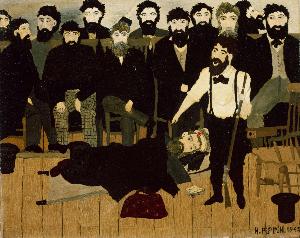Horace Pippin
Horace Pippin
Place: West Chester
Born: 1888
Death: 1946
Biography:
, a self-taught American artist, was born on February 22, 1888, and passed away on July 6, 1946. He is known for his diverse range of themes, including scenes inspired by his service in World War I, landscapes, portraits, and biblical subjects.
Early Life and Career
Pippin's artistic journey began with no formal training, yet he managed to develop a unique style that captured the essence of various genres. His experiences during World War I had a significant impact on his work, as seen in his War Scenes paintings. Pippin's artwork also addressed the U.S.'s history of slavery and racial segregation, making him a prominent figure in American art.
Notable Works and Achievements
Some of Pippin's most notable works include Scenes from World War I, Landscapes, and Biblical Subjects. He was the first Black artist to be the subject of a monograph, Selden Rodman's Horace Pippin, A Negro Painter in America (1947). The New York Times eulogized him as the 'most important Negro painter' in American history.
Legacy and Commemoration
Pippin is buried at Chestnut Grove Cemetery Annex in West Goshen Township, Pennsylvania. A Pennsylvania State historical marker at 327 Gay Street, West Chester, Pennsylvania, identifies his home at the time of his death and commemorates his accomplishments.
- Pippin's artwork can be found on Wikioo.org, where you can explore his collection and learn more about his life and work.
- His paintings are also featured in the New Hope Museum of Art, which is a significant contributor to the preservation and promotion of American art.
- Pippin's legacy continues to inspire artists, and his work remains an important part of American art history.
of Pippin's artwork include: * His unique style, developed without formal training * His experiences during World War I and their impact on his work * His addressing of the U.S.'s history of slavery and racial segregation Pippin's story serves as an inspiration to artists and art enthusiasts alike, showcasing the power of self-taught talent and dedication. His legacy continues to be celebrated through his artwork, which can be found in various museums and online platforms, including Wikioo.org.




